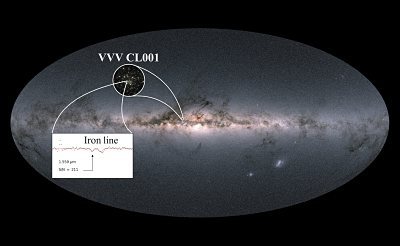Data
You will be redirected to cenamweb.org in 15 second(s). The JINA-CEE website is not updated anymore. The archived website can still be reached through the CeNAM website.
Astrophysicists Discover the Most Metal-poor Globular Cluster in the Milky Way’s Interior

Originally published by Carnegie Science
The study was led by astronomers from the Sloan Digital Sky Survey IV and identified stars very poor in iron content in a globular cluster located in a region of the galactic bulge that is heavily obscured by interstellar dust, making it virtually invisible in the optical.
Globular clusters are groupings of thousands, or even millions, of ancient stars. They have existed since the earliest epochs of galaxy formation and are considered important systems that provide relevant clues about their parent galaxies. Our Milky Way is home to a unique collection of more than 150 of these ancient systems. A significant fraction of them reside in the inner regions of the galaxy and move in confined orbits a few kpc (< 26,000 light-years) within the Sun’s orbit. In these inner regions of the Milky Way more than a hundred globular clusters have been studied and discovered with an iron content ranging from ~0.5% to 88% of the iron content observed in our Sun.
However, this view has recently changed with the discovery of two red giant stars with extremely low iron content, identified in the innermost regions of the globular cluster VVV CL001. These stars contain less iron in their stellar atmospheres, much less than 0.3% of the iron contained in the Sun. This makes VVV CL001 one of the potential candidates to belong to an exotic and rare family of ancient, extremely iron-deficient globular clusters identified in the interior of our galaxy.
This research was carried out by an international group of scientists led by Dr. José G. Fernández-Trincado (Université Bourgogne – Franche Comté/Universidad de Atacama), in collaboration with Dr. Dante Minniti (Universidad Andrés Bello, Chile), Dr. Timothy C. Beers (University of Notre Dame, USA), Stefano Oliveira de Souza (PhD student, University of São Paulo, Brazil), and other researchers from several countries, including the USA, France, Brazil, Chile and Mexico.
The research, which was published in the prestigious journal The Astrophysical Journal Letters, uses data from multiple astronomical surveys, including the Vista Variables in the Via Lactea eXtended Survey (VVVX) and the European Space Agency’s Gaia mission. In addition, one of the twin spectrographs of the Apache Point Observatory Galactic Evolution Experiment (APOGEE-2) survey, installed on the Irénée du Pont telescope at Las Campanas Observatory, was used.
The very low iron content identified in VVV CL001 places this object at the extreme metallicity limit known to astronomers as the metallicity floor, which has important consequences for understanding the assembly of these systems in the Universe, and theories about the formation of galaxies at early times. In the Milky Way, only two globular clusters are known to be in this extreme metallicity regime: VVV CL001, which roams the inner regions of the galaxy, and ESO280-SC06, beyond the orbit of the Sun.
VVV CL001 was discovered by Dr. Dante Minniti (second co-author of the present study) a decade ago using near-infrared photometry provided by the VISTA Variables in the Milky Way (VVV) project, one of six public ESO surveys using the 4-meter visible and infrared survey telescope (VISTA).
Until recently, a detailed study of the chemical composition of VVV CL001 was not possible due to the large amount of obscuration produced by interstellar matter dust in the interior of our galaxy. However, using near-infrared spectroscopy with one of the twin spectrographs of the Apache Point Observatory Galactic Evolution Experiment (APOGEE-2) survey, installed on the Irénée du Pont 2.5-meter telescope at Las Campanas Observatory, Chile, as part of the Sloan Digital Sky Survey IV collaboration spectroscopic survey allowed penetrating the interstellar dust barriers to obtain, for the first time, detailed information on the chemical composition of the interior of VVV CL001. Both photometry and near-infrared spectroscopy have made it possible to collect those valuable photons that made it through the interstellar dust.
“Many aspects of our discovery point to VVV CL001 possibly being a satellite ripped from a dwarf galaxy that was completely devoured by the Milky Way more than 10 billion years ago. The finding of very metal-poor globular clusters such as VVV CL001 are atypical in galaxies like ours, and their discovery has important implications for theories of how galaxies form in the Universe,” explains Dr. José G. Fernández-Trincado.
The new stellar spectra provide individual physical characteristics of the stars in the innermost regions of the cluster, such as their surface temperatures and gravities, but can also provide their velocity in the radial direction (i.e., we can tell whether they are moving away from or towards us and how fast they are moving), and also their chemical composition (for some chemical species such as nitrogen, oxygen, magnesium, aluminum, silicon, and iron) from multiple observations.
New observations with the VVVX near-infrared survey have allowed estimating for the first time an age of about twelve billion years for VVV CL001.
In the interior of the Milky Way, says Fernández-Trincado, there are another hundred or so globular cluster candidates and the goal of the research group is to reveal their chemical history and verify how frequent globular clusters with the properties observed in VVV CL001 are, as well as to know what implications they have on the formation scenario of our Milky Way and other galaxies similar to ours in the Universe.
Contact:
José G. Fernández-Trincado
- Assistant Professor/Universidad de Atacama/Chile
- Research Associate/Université Bourgogne-Franche-Comté/France
- Email: jfernandez@obs-besancon.fr y/o jose.fernandez@uda.cl
Dante Minniti
- Full professor/Universidad Andrés Bello/Chile
- Email: vvvdante@gmail.com
Timothy C. Beers
- Grace-Rupley Professor of Physics/University of Notre Dame/USA
- Email: timothy.C.Beers.5@nd.edu
